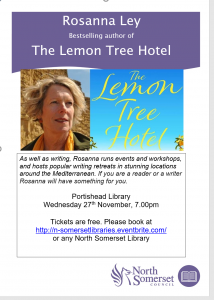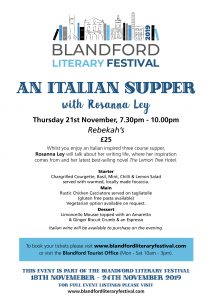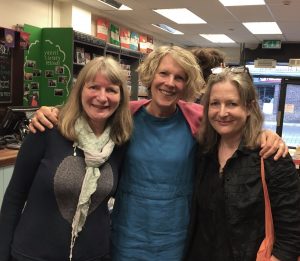Portishead Visit
 Portishead Library won the recent Reading Agency competition for best summer display of lemony things for The Lemon Tree Hotel and so I am delighted to be paying them a visit on Wednesday 27th November. Tickets are free!
Portishead Library won the recent Reading Agency competition for best summer display of lemony things for The Lemon Tree Hotel and so I am delighted to be paying them a visit on Wednesday 27th November. Tickets are free!
An Italian Supper
 Here’s the delicious menu for our Italian supper in Blandford Forum Thursday 21st November.
Here’s the delicious menu for our Italian supper in Blandford Forum Thursday 21st November.
I will be talking about The Lemon Tree Hotel and answering questions about writing process and research – so there will be lots of bookish chat…
I’m delighted to be part of Blandford’s first literary festival and wish them all the best for many successful events.
Spirit of Place

It’s hard to define the ‘spirit of place’ which is the subject up for discussion at Bridport Library on Sunday 3rd November 2019 as part of the Bridport Literary Festival.
The authors who will be discussing the ‘spirit of place’ are myself, Maria Donovan author of ‘The Chicken Soup Murder’ who has just been named First Prize winner of the Bridport Prize in the category of flash fiction and Gail Aldwin author of ‘The String Games.’ Place is an important element for all of us in our writing.
Speaking for myself, I am a keen traveller and my interest in other countries and cultures has led me to write many ‘destination’ novels in which I explore places such as Italy, Spain, Cuba, Burma and Morocco through the eyes of my character(s). This involves a lot of research about the history/ legends/ cultural practices/ people/ politics/ food etc before I even go there to (hopefully) find the true flavour.
I go to these places to walk the same pathways as my characters, to see the place as they would see it, to eat the same food and so on. Once there, I can watch, listen and observe. I can choose more specific venues there – for example, houses in which my characters might live, places in which they might work or walk to; settings in which certain scenes might take place. I can make notes and take photographs and then when I eventually write the scene, I can hopefully get as close as possible to the experience. Ideally, I can write some of my scenes while living in that place too.
Perhaps many of us want change; even to be ‘transported’ somewhere by a piece of writing, to feel that they are living for a brief time in a different world?
Stories come from places and from people; from the landscape and the culture. For me, a place might be my choice because it fits in with a theme I want to explore in a novel (for example in ‘Her Mother’s Secret’ I wanted to write about an island and how islands can be both claustrophobic and also somewhere to escape to – Belle-ile-en-mer off Brittany, France, fitted the bill completely). It can be part of the story already as Burma was for me in ‘Return to Mandalay’ a book in which I explored a fictional version of my late father-in-law’s true life story. Or it can be a place that means a lot to me, in which I want to spend some time (like ‘The Lemon Tree Hotel’). It is more than another character in a novel. It is the setting and creates the mood, the atmosphere, the all-important ‘feel’.
The ‘spirit’ of a place can draw us to visit and to eventually live our lives there. I spent many years visiting and writing about West Dorset before I moved here and made it my home.
But what is it that draws and interests us? Is it the people, the landscape, the pace of life..? Or is it something much harder to define that speaks to our soul and makes us feel that this is truly ‘home?’

News
- Writing Beneath the Surface
- Summer Scorchers 2025
- The Feelgood Festival in Oslo
- Winter Hotties 2024/5
- Autumn Reading 2024
- Summer Reading 2024
- Finca Writing in March and June 2024
- My Spring Fiction 2024
- Themes and Schemes
- Top Winter Titles
- Autumn Leaves
- Summer Pages
- Spring Reading Delights
- Writing at the Finca in March
- Winter Chillers
- Autumn Pages
- Researching in Liguria
- Writing at the Finca in July
- Summer Sizzlers 2022
- Spring Reading 2022
- Flash Fiction Slam at BAC
- Writing at the Finca March 2022
- I Am Editing…
- It’s getting colder – time for some late Autumn goodies…
- Writing and Researching during a Pandemic
- Summer Sizzlers – my summer reading
- The Seville Orange and Almond Cake
- The Writing Walk
- Winter Reading Hotties
- Returning to Belle-ile-en-mer
- The Creation of a New World (to Everyone who Does It)
- Autumn Warmers
- Research in the Walled Gardens
- Late Summer Reading…
- Writing Cinematically
- June News
- Spring Reading (In Lockdown…)
- Returning to Mandalay
- Writing at the Finca in February
- Winter Reading
- Oranges in Seville
- Autumn Reading
- Portishead Visit
- An Italian Supper
- Spirit of Place
- Writing at Finca el Cerrillo – seven reasons for a group leader to host a Writing Holiday
- Summer Reading – 8 books to add to your summer tbr pile
- Self-Promotion – how ready are you to shout about it?
- Featuring The Lemon Tree Hotel
- On the Scent of a Storyline